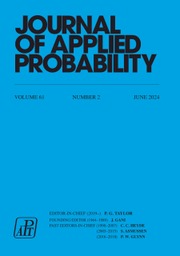No CrossRef data available.
Article contents
Rates for the SLLN for long-memory and heavy-tailed processes
Published online by Cambridge University Press: 24 June 2025
Abstract
The present paper develops a unified approach when dealing with short- or long-range dependent processes with finite or infinite variance. We are concerned with the convergence rate in the strong law of large numbers (SLLN). Our main result is a Marcinkiewicz–Zygmund law of large numbers for  $S_{n}(f)= \sum_{i=1}^{n}f(X_{i})$, where
$S_{n}(f)= \sum_{i=1}^{n}f(X_{i})$, where  $\{X_i\}_{i\geq 1}$ is a real stationary Gaussian sequence and
$\{X_i\}_{i\geq 1}$ is a real stationary Gaussian sequence and  $f(\!\cdot\!)$ is a measurable function. Key technical tools in the proofs are new maximal inequalities for partial sums, which may be useful in other problems. Our results are obtained by employing truncation alongside new maximal inequalities. The result can help to differentiate the effects of long memory and heavy tails on the convergence rate for limit theorems.
$f(\!\cdot\!)$ is a measurable function. Key technical tools in the proofs are new maximal inequalities for partial sums, which may be useful in other problems. Our results are obtained by employing truncation alongside new maximal inequalities. The result can help to differentiate the effects of long memory and heavy tails on the convergence rate for limit theorems.
Keywords
MSC classification
Information
- Type
- Original Article
- Information
- Copyright
- © The Author(s), 2025. Published by Cambridge University Press on behalf of Applied Probability Trust


